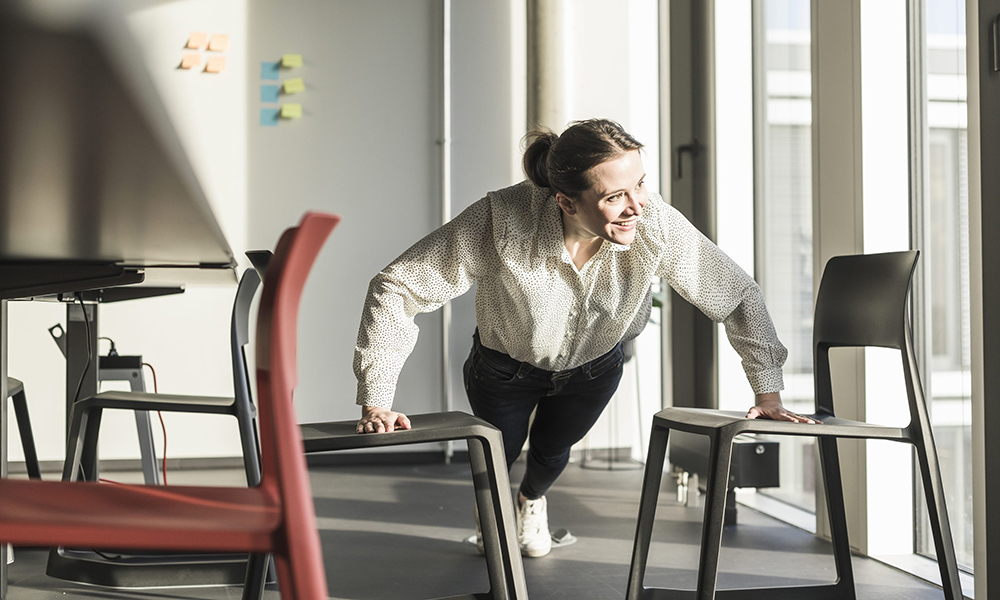只运动30秒也有益健康,日常生活如何见缝插针地运动?

也许你已经制定了新年计划——今年的目标是变得更健康。如果是这样的话,有相同的目标的人大有人在:统计数据显示,人们制定的首要新年计划是增强体质。遗憾的是,大多数人发现坚持完成计划困难重重。一年过去了,只有约9%的人表示他们在整整一年中坚持完成了新锻炼计划。
让锻炼成为一种持续的、有规律的习惯是非常艰难的,尤其是当你要兼顾事业、家庭责任和其他时间需求时。将运动"零食"融入日常活动是一个很好的起点,或者说是在现有运动习惯中增加碎片化运动的好方法。这些分散在日常日程中的短暂活动可以改变你的感受和整体健康状况。
“即使不是参加专业的锻炼课程,运动也对我们大有裨益。”马里兰州Recharge Health & Fitness的理疗医生梅根·维塞尔(Meghan Wieser)说。“运动零食这样的运动方式门槛低,能让你的身体一整天都动起来,有助于改善健康指标。”
研究证实了这一点。安大略省汉密尔顿市麦克马斯特大学(McMasters University)的一个研究小组验证了这一理论。这项研究调查了20秒爬楼梯式剧烈运动(每周三天,每天三次)是否能改善心肺健康状况。六周后,实验参与者的心肺健康功能改善了约5%。运动机能学教授马丁·吉巴拉(Martin Gibala)说:“变化不大,但并非微不足道。通过研究流行病学数据,我们了解到,微小的变化也大有助益。”
虽然重复性的运动零食不应该取代包括心血管和力量训练在内的更有规律的日常锻炼,但它可以改善你的健康状况。它还可以作为一个简单的切入点,让你在新的一年里变得更健康。
如何开始
维塞尔说,将运动零食纳入日常日程的最佳方法之一是“习惯叠加”。她说:“在特定的一天里,你已经养成了一些习惯,比如上午十点的咖啡时间。因此,当你在等咖啡煮好的时候,可以见缝插针地运动一下。”
例如,也许你每天下午2点都要与团队进行一次Zoom通话。在电话开始前五分钟,利用这个机会做一次微量运动。从办公桌前起身去洗手间也能起到同样的作用。你也可以选择番茄工作法,通过设置计时器来提醒你在特定时间间隔后进行运动,从而增强体质。或者,如果你佩戴健身追踪器,也可以将其设置为每隔几小时发出嗡嗡声,以友好的方式提醒你进行运动。关键是要有意识地进行运动,并将其叠加到日常活动和习惯中,这样更容易记住要运动,并将其融入现有日程中。
如何运动以及运动多长时间这一问题范围很广,这取决于您现有的体能基线。例如,一个久坐不动的人可能不会一开始就一次跑楼梯20秒。目标是进行各种有益于心肺和肌肉的运动。
简单的切入点可以包括深蹲、弓步、俯卧撑、原地慢跑、做几组开合跳,或者在走廊里健步走等。如果你更喜欢静态运动,可以每次做30秒的靠墙半蹲,重复三次,或者趴在地板上做30秒的平板支撑。尝试把这些运动混合起来,给身体带来各种刺激,争取至少每两小时左右运动一次。
吉巴拉说:"没有哪一种运动比其他运动更好,但你应该以锻炼大肌肉群为目标,同时提高心率。无论有没有器械辅助,完成复杂的、多关节功能性运动都大有裨益。你需要锻炼到气喘吁吁,才能从中获益。”
这是短时间运动的关键之一——有些运动的强度应该足以提高心率。吉巴拉说:“但也应该是你喜欢的运动,这样你才会坚持下去。比如,波比跳就非常有效,但并不是每个人都喜欢。”
你也不必把运动零食局限于工作日,或严格按照计划进行。研究表明,将日常间歇性剧烈体能活动(VILPA,定义为每次剧烈活动时间不超过1或2分钟)融入日常生活也会产生益处。即使每天进行三次运动,每次持续一到两分钟,也能降低心血管疾病和癌症死亡率。吉巴拉说:“想象一下这样的场景,你坐了三个小时的飞机,从飞机上下来后,提着行李箱爬机场楼梯。花几分钟时间和孩子们尽力玩耍。将这一活动与运动零食同步,就会有大有裨益。”
综上所述,你的目标仍然应该是长时间的、有目的的锻炼。但作为一种补充——或者如果你只有进行碎片化运动的时间——同样可以改善你的健康状况。“把零食当作一种补充。”维塞尔说。“这是你一天中摄入的小零食,可以滋补身体。”(财富中文网)
译者:中慧言-王芳
也许你已经制定了新年计划——今年的目标是变得更健康。如果是这样的话,有相同的目标的人大有人在:统计数据显示,人们制定的首要新年计划是增强体质。遗憾的是,大多数人发现坚持完成计划困难重重。一年过去了,只有约9%的人表示他们在整整一年中坚持完成了新锻炼计划。
让锻炼成为一种持续的、有规律的习惯是非常艰难的,尤其是当你要兼顾事业、家庭责任和其他时间需求时。将运动"零食"融入日常活动是一个很好的起点,或者说是在现有运动习惯中增加碎片化运动的好方法。这些分散在日常日程中的短暂活动可以改变你的感受和整体健康状况。
“即使不是参加专业的锻炼课程,运动也对我们大有裨益。”马里兰州Recharge Health & Fitness的理疗医生梅根·维塞尔(Meghan Wieser)说。“运动零食这样的运动方式门槛低,能让你的身体一整天都动起来,有助于改善健康指标。”
研究证实了这一点。安大略省汉密尔顿市麦克马斯特大学(McMasters University)的一个研究小组验证了这一理论。这项研究调查了20秒爬楼梯式剧烈运动(每周三天,每天三次)是否能改善心肺健康状况。六周后,实验参与者的心肺健康功能改善了约5%。运动机能学教授马丁·吉巴拉(Martin Gibala)说:“变化不大,但并非微不足道。通过研究流行病学数据,我们了解到,微小的变化也大有助益。”
虽然重复性的运动零食不应该取代包括心血管和力量训练在内的更有规律的日常锻炼,但它可以改善你的健康状况。它还可以作为一个简单的切入点,让你在新的一年里变得更健康。
如何开始
维塞尔说,将运动零食纳入日常日程的最佳方法之一是“习惯叠加”。她说:“在特定的一天里,你已经养成了一些习惯,比如上午十点的咖啡时间。因此,当你在等咖啡煮好的时候,可以见缝插针地运动一下。”
例如,也许你每天下午2点都要与团队进行一次Zoom通话。在电话开始前五分钟,利用这个机会做一次微量运动。从办公桌前起身去洗手间也能起到同样的作用。你也可以选择番茄工作法,通过设置计时器来提醒你在特定时间间隔后进行运动,从而增强体质。或者,如果你佩戴健身追踪器,也可以将其设置为每隔几小时发出嗡嗡声,以友好的方式提醒你进行运动。关键是要有意识地进行运动,并将其叠加到日常活动和习惯中,这样更容易记住要运动,并将其融入现有日程中。
如何运动以及运动多长时间这一问题范围很广,这取决于您现有的体能基线。例如,一个久坐不动的人可能不会一开始就一次跑楼梯20秒。目标是进行各种有益于心肺和肌肉的运动。
简单的切入点可以包括深蹲、弓步、俯卧撑、原地慢跑、做几组开合跳,或者在走廊里健步走等。如果你更喜欢静态运动,可以每次做30秒的靠墙半蹲,重复三次,或者趴在地板上做30秒的平板支撑。尝试把这些运动混合起来,给身体带来各种刺激,争取至少每两小时左右运动一次。
吉巴拉说:"没有哪一种运动比其他运动更好,但你应该以锻炼大肌肉群为目标,同时提高心率。无论有没有器械辅助,完成复杂的、多关节功能性运动都大有裨益。你需要锻炼到气喘吁吁,才能从中获益。”
这是短时间运动的关键之一——有些运动的强度应该足以提高心率。吉巴拉说:“但也应该是你喜欢的运动,这样你才会坚持下去。比如,波比跳就非常有效,但并不是每个人都喜欢。”
你也不必把运动零食局限于工作日,或严格按照计划进行。研究表明,将日常间歇性剧烈体能活动(VILPA,定义为每次剧烈活动时间不超过1或2分钟)融入日常生活也会产生益处。即使每天进行三次运动,每次持续一到两分钟,也能降低心血管疾病和癌症死亡率。吉巴拉说:“想象一下这样的场景,你坐了三个小时的飞机,从飞机上下来后,提着行李箱爬机场楼梯。花几分钟时间和孩子们尽力玩耍。将这一活动与运动零食同步,就会有大有裨益。”
综上所述,你的目标仍然应该是长时间的、有目的的锻炼。但作为一种补充——或者如果你只有进行碎片化运动的时间——同样可以改善你的健康状况。“把零食当作一种补充。”维塞尔说。“这是你一天中摄入的小零食,可以滋补身体。”(财富中文网)
译者:中慧言-王芳
Maybe you’ve set a New Year’s resolution to get fitter and healthier this year. If so, you’re in good company: statistics show that improving fitness is the number one resolution. Unfortunately, the majority of people find sticking to that resolution difficult. A year on, only about 9% report they’ve stayed with a new exercise regimen for the entire 12 months.
Making exercise a consistent, regular habit is hard, especially when you’re juggling a career, family obligations, and other demands on your time. A good starting point—or simply a good way to add on to an existing exercise habit—is to integrate movement “snacks” into your routine. These short bursts of activity scattered throughout your day can make a difference in how you feel, as well as your overall health.
“Movement is good for us, even if it’s not a dedicated exercise session,” says Meghan Wieser, a doctor of physical therapy at Maryland-based Recharge Health & Fitness. “Movement snacks can be a low-barrier way to get your body moving throughout the day, and it correlates with better health markers.”
Research backs this up. A team at McMasters University in Hamilton, Ontario, tested the theory. The study looked into whether simple 20-second bursts of vigorous stair climbing, three times each day, performed three days a week, could improve cardiorespiratory fitness. After six weeks, it had, by about 5%. “The changes are modest, but not insignificant,” says co-author Martin Gibala, a professor of kinesiology. “By studying epidemiological data, we’ve learned that small changes can go a long way.”
While repeated exercise snacks shouldn’t replace a more regular workout routine that includes both cardiovascular and strength training, it can improve your health. It can also serve as an easy entry point to getting fitter in the new year.
How to get started
One of the best ways to incorporate movement snacks into your day is to “habit stack,” says Wieser. “In a given day, you already have habits built in, like a mid-morning coffee break,” she says. “So while you’re waiting for the coffee to brew, fit in some movement.”
Maybe you have a daily 2 p.m. zoom call with your team, for instance. Five minutes before it begins, take the chance to do a micro-session of exercise. The same with getting up from your desk to walk to the bathroom. You can also choose to Pomodoro Method your way to better health by setting a timer to remind you to move after a specific interval of time. Or if you wear a fitness tracker, set it to buzz every couple of hours as a friendly nudge to move. The point is getting intentional about movement, and stacking it on top of existing routines and habits makes it easier to remember and incorporate.
How you move and for how long can run a wide spectrum, and is dependent on your existing baseline of fitness. Someone who is fully sedentary, for instance, probably won’t start with sprinting up the stairs for 20 seconds at a time. Aim for a variety of movement that benefits both your heart and lungs, as well as your muscles.
Easy entry points can include movements like air squats, lunges, push-ups, jogging in place, doing a few sets of jumping jacks, or setting out for a vigorous walk down the hall. If you prefer more static movement, hold a wall sit for 30 seconds at a time, repeating three times,. Or get on the floor and hold a plank for a similar period of time. Try to mix it up to give your body a variety of stimuluses, and aim to move at least every two hours or so.
“No one type of exercise is better than any other, but you should aim to engage your large muscle groups to get your heart rate elevated at the same time,” says Gibala. “Complex, multi-joint functional movements, with or without equipment are good. You need to huff and puff a bit to get the benefit.”
And that’s one of the keys with shorter bursts of activity—some should be intense enough to raise your heart rate. “But it should be something you like so that you’ll stick with it,” says Gibala. “Burpees are fantastic, for example, but not everyone likes them.”
You don’t have to limit your movement snacks to the workday, or strictly with a plan in mind, either. Research shows that incorporating vigorous intermittent lifestyle physical activity (VILPA) into everyday life can be impactful as well. Even at a frequency of three times per day, lasting one or two minutes each is associated with reduced cardiovascular disease and cancer mortality. “Think about getting off a three-hour flight, where you’ve been sitting the whole time, and walking up the stairs in the airport with your suitcase in hand,” says Gibala. “Play hard with your kids for a few minutes. Parallel this with movement snacks and it can go a long way.”
All that says, your goal should still be longer, intentional exercise sessions. But as an add on—or if time for an exercise snack is all you’ve got—you can improve your health. “Consider snacks a supplement,” says Wieser. “It’s a little nibble throughout your day that feeds your body.”













